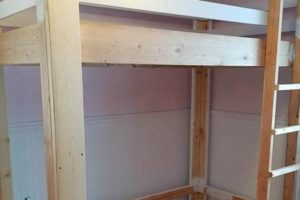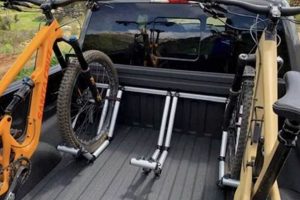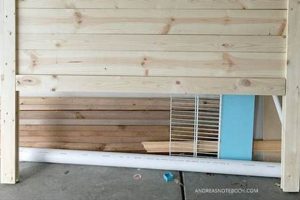The phrase refers to the construction of a support system, typically mounted within the cargo area of a pickup truck, designed to securely transport bicycles. For example, individuals may create a rack using lumber and fasteners to prevent bikes from shifting during transit.
Such construction offers several advantages, including potential cost savings compared to purchasing commercially manufactured options and the ability to customize the rack’s dimensions and features to accommodate specific bicycle types or quantities. Historically, resourceful individuals have often opted for self-built solutions to meet transportation needs due to economic factors or a desire for tailored functionality.
The following sections will explore common materials, design considerations, and construction techniques for building a stable and effective in-bed bike transport system.
Tips for In-Bed Bicycle Rack Construction
These suggestions offer guidance for constructing a durable and functional bicycle rack within a truck bed, emphasizing safety and security for transported bikes.
Tip 1: Material Selection: Opt for pressure-treated lumber or exterior-grade plywood to withstand exposure to the elements. Metal components should be coated with rust-resistant paint or powder coating.
Tip 2: Secure Fastening: Employ robust fasteners, such as carriage bolts and locking nuts, to ensure structural integrity. Avoid relying solely on screws, which can loosen over time due to vibrations.
Tip 3: Wheel Chock Design: Incorporate wheel chocks that conform to the bicycle tire size to prevent movement during transit. Adjustable chocks can accommodate varying tire widths.
Tip 4: Frame Protection: Implement padding or soft material at contact points between the rack and bicycle frames to prevent scratches or damage.
Tip 5: Anchor Points: Utilize existing truck bed tie-down points to secure the rack. If unavailable, consider installing additional anchor points to ensure stability.
Tip 6: Height Considerations: Design the rack with sufficient vertical clearance to prevent bicycles from contacting the truck cab or tonneau cover.
Tip 7: Weight Distribution: Distribute the weight of the bicycles evenly across the truck bed to maintain vehicle stability and handling.
Adhering to these recommendations will contribute to the construction of a secure and reliable in-bed bicycle rack, minimizing the risk of damage to bicycles and ensuring safe transportation.
The following section will address safety precautions related to the use of the constructed rack.
1. Material Durability
The longevity and reliability of a self-constructed bicycle rack for a truck bed are intrinsically linked to the materials chosen for its fabrication. The intended purpose of the rack supporting and securing bicycles during transit, often under variable environmental conditions necessitates a careful assessment of material properties and suitability.
- Weather Resistance
Exposure to rain, sun, and temperature fluctuations can degrade materials over time. Untreated wood, for instance, will rot and weaken, compromising the rack’s structural integrity. Similarly, unprotected steel is susceptible to corrosion, reducing its load-bearing capacity. The selection of weather-resistant materials or the application of protective coatings is therefore paramount in ensuring the rack’s long-term usability. For example, pressure-treated lumber or powder-coated steel offer enhanced resistance to environmental degradation.
- Load-Bearing Capacity
The materials must be able to withstand the weight and dynamic forces exerted by the bicycles during transport. The combined weight of the bicycles, coupled with vibrations and sudden movements, can place significant stress on the rack’s components. Insufficient load-bearing capacity can lead to material failure, resulting in damage to the bicycles and potential safety hazards. Steel and certain hardwoods possess high strength-to-weight ratios, making them suitable choices for structural elements.
- Resistance to Abrasion and Impact
Contact between the rack and the bicycles, as well as potential impacts from external sources, can cause abrasion and wear. Materials prone to scratching or denting may compromise the rack’s aesthetic appeal and, more importantly, its structural integrity. Implementing durable surface finishes or incorporating protective padding can mitigate these effects. For instance, applying a rubberized coating to contact points can minimize abrasion.
- Fastener Compatibility
The chosen materials must be compatible with appropriate fasteners, such as bolts, screws, and adhesives. Using incompatible fasteners can lead to weak joints and structural instability. For example, using self-tapping screws in thin-walled metal tubing may not provide sufficient holding power. Selecting fasteners that are specifically designed for the chosen materials is essential for creating a robust and reliable structure.
In summary, the material selection process for a self-built bicycle rack for a truck bed requires careful consideration of environmental factors, load-bearing requirements, and compatibility with fastening methods. Prioritizing material durability is essential for ensuring the rack’s safety, longevity, and effectiveness in securely transporting bicycles.
2. Secure Mounting
Secure mounting is a critical component of any bicycle rack constructed for truck bed use. The integrity of the entire system hinges on the rack’s ability to remain firmly affixed to the truck bed, preventing movement during transit. Insufficiently secured racks can shift, potentially damaging bicycles, the truck itself, or creating a hazard for other vehicles. For example, a rack that relies solely on friction to stay in place is likely to slide during sudden braking or cornering, increasing the risk of bicycle dislodgement.
Effective securement often involves utilizing existing truck bed features such as tie-down points. Alternatively, strategically placed bolts or clamps can attach the rack to the bed rails or sides. The selection of mounting hardware and techniques should be appropriate for the truck bed material and the weight of the bicycles being transported. Racks constructed from wood may require different mounting solutions compared to those made from metal. Furthermore, designs that distribute the load across multiple mounting points enhance stability and minimize stress on any single attachment. Careful planning and execution of the mounting process are essential for creating a safe and reliable bicycle transport solution.
Ultimately, robust and well-engineered secure mounting transforms a potentially hazardous self-made rack into a dependable asset for transporting bicycles. The challenges lie in adapting designs to diverse truck bed configurations and ensuring the chosen method can withstand the dynamic forces encountered during travel. Understanding the principles of secure mounting is paramount for anyone undertaking the creation of a bicycle rack for truck bed application.
3. Bicycle Protection
The safeguarding of bicycles during transport constitutes a primary consideration in the design and construction of a self-built rack for truck bed application. The integrity of the bicycle frame, components, and finish can be compromised by inadequate support, impact, and abrasion encountered during vehicular movement. Therefore, a well-designed rack must proactively address potential damage vectors. For example, a rack that lacks secure wheel chocks may permit the bicycle to shift during cornering or braking, resulting in frame damage against the truck bed or other bicycles. Similarly, contact points between the rack and the bicycle frame lacking protective padding can lead to paint scratches and wear, diminishing the bicycle’s aesthetic and resale value.
Effective measures for bicycle protection within a truck bed rack system include the incorporation of padded cradles or supports that conform to the frame geometry, preventing direct contact with rigid surfaces. Additionally, securing the bicycle wheels using straps or clamps can minimize movement and prevent wheel damage. A rack designed to accommodate multiple bicycles must ensure adequate spacing to prevent bikes from colliding during transit. For instance, fork-mount designs, while offering secure frame attachment, necessitate careful consideration of fork protection, especially for carbon fiber forks that are susceptible to damage from overtightening. Furthermore, securing loose components such as pedals and handlebars prevents them from causing damage to the truck bed or other bicycles.
In summary, bicycle protection is an inextricable element of rack construction. Neglecting this aspect can lead to preventable damage and diminished value of the transported bicycles. The effectiveness of a self-built solution is measured not only by its ability to transport bicycles, but also by its capacity to preserve their condition throughout the journey. Prioritizing protective features during the design and build phases ensures a sustainable and valuable investment for cyclists utilizing truck bed transport solutions.
4. Space Optimization
Space optimization, concerning a self-made bicycle rack within a truck bed, relates to maximizing the usable area within the truck while securely accommodating bicycles. Effective use of available space ensures that the truck retains utility beyond bicycle transport.
- Vertical Arrangement
The employment of vertical designs enables multiple bicycles to be transported within a smaller footprint compared to horizontal configurations. Elevating bicycles allows for storage beneath them or alongside, retaining space for other cargo. An example is a rack that positions bicycles upright, securing them by the front fork or wheel, thus minimizing the area occupied on the truck bed floor.
- Collapsible Structures
Racks that can be folded or disassembled when not in use contribute to optimized space. A collapsible structure permits the truck bed to return to its original, unobstructed state for general cargo hauling. Folding side supports or removable wheel mounts exemplify this feature.
- Compartmentalization
Integration of storage compartments within the rack design facilitates the organization of tools, cycling gear, and other essentials. Compartments can be incorporated into the rack’s base or along its sides, maximizing otherwise unused space. This feature reduces clutter and enhances accessibility to cycling-related items.
- Contoured Design
Adapting the rack’s shape to conform to the truck bed’s contours, particularly around wheel wells, maximizes available space. Designs that follow the truck bed’s lines allow for a snug fit, minimizing wasted space and ensuring the rack integrates seamlessly with the vehicle. This approach requires precise measurements and potentially custom fabrication to achieve an optimal fit.
Space optimization, therefore, enhances the practicality of truck bed bicycle racks, promoting efficient usage of available volume. Strategic employment of design principles ensures that the rack does not unduly compromise the truck’s functionality as a cargo carrier.
5. Weight Distribution
Weight distribution represents a critical factor in the design and implementation of any bicycle rack intended for truck bed use. Improper weight distribution can significantly compromise vehicle handling, stability, and braking performance, leading to unsafe driving conditions. The placement of bicycles and the rack itself within the truck bed directly influences the vehicle’s center of gravity and load balance. For instance, concentrating the weight towards the rear of the truck bed can reduce steering control and increase the risk of fishtailing, especially during sudden maneuvers or adverse weather conditions. Similarly, uneven weight distribution from side to side can cause the vehicle to lean excessively during turns, reducing stability. This effect is magnified in taller vehicles with a higher center of gravity.
To mitigate these risks, a DIY bicycle rack design must prioritize even distribution of the load across the truck bed. This often involves positioning bicycles symmetrically around the centerline of the vehicle and minimizing overhang beyond the rear axle. Utilizing wider support bases for the rack can further distribute the weight and enhance stability. Real-world examples underscore the importance of this principle. Overloading one side of a truck bed with bicycles, even when the total weight is within the vehicle’s specified limits, can lead to premature wear on suspension components and increased fuel consumption due to uneven tire wear. Furthermore, exceeding the load capacity of the rear axle can compromise braking effectiveness and increase stopping distances. Careful consideration of these factors is paramount during the design and construction phases of a DIY rack project.
In summary, ensuring proper weight distribution is not merely an aesthetic consideration but a fundamental safety requirement for a functional bicycle rack. By strategically positioning bicycles, distributing the load across the truck bed, and avoiding excessive overhang, operators can maintain vehicle stability, handling, and braking performance. Failure to address this critical aspect can lead to compromised safety and increased risk of accidents. Therefore, DIY rack builders must prioritize weight distribution alongside other design considerations, such as material strength and secure mounting, to create a safe and reliable bicycle transport solution.
6. Ease of Access
Accessibility directly impacts the practicality and usability of a self-constructed bicycle rack intended for a truck bed. The convenience with which bicycles can be loaded, secured, and unloaded significantly influences the overall user experience and the frequency of rack utilization.
- Loading Height and Reach
The vertical distance required to lift a bicycle onto the rack is a primary factor. High loading heights necessitate greater physical exertion and may prove challenging for some individuals. Design considerations should account for varying user strengths and bicycle weights. Ramps or lower mounting points can mitigate these challenges. For example, a rack positioned high in the truck bed necessitates lifting the bicycle over the bed sides, potentially requiring assistance or specialized equipment.
- Securement Mechanisms
The complexity and speed of the bicycle securement process influence accessibility. Intricate strapping systems or cumbersome clamping mechanisms can deter frequent use. Simplified, user-friendly securement methods enhance convenience. A quick-release system that allows for rapid attachment and detachment of bicycles promotes ease of use. Conversely, a system that requires numerous steps and tools can discourage users, particularly for short trips.
- Rack Deployment and Storage
The ease with which the rack can be installed, removed, or stored affects its overall practicality. Racks that require extensive assembly or consume significant storage space may prove less desirable. Designs that incorporate modular components or folding mechanisms enhance accessibility. For instance, a rack that can be easily folded and stored against the truck cab when not in use maximizes cargo space and minimizes storage requirements.
- Accessibility to Other Cargo
The rack’s design should not unduly impede access to other items in the truck bed. A rack that occupies the entire bed or obstructs access to tie-down points can limit the truck’s utility. Strategic placement of the rack and consideration of alternative storage solutions can mitigate these limitations. For example, a rack designed to accommodate storage containers underneath or alongside the bicycles preserves the truck’s cargo-carrying capacity.
Integrating ease-of-access considerations into the design of a self-made bicycle rack for a truck bed significantly enhances its usability and practicality. By addressing loading height, securement mechanisms, rack deployment, and cargo access, the overall user experience is optimized, promoting frequent and convenient use of the rack for bicycle transportation.
Frequently Asked Questions
This section addresses common inquiries regarding the construction and implementation of self-made bicycle racks for truck beds, providing clarity on essential aspects.
Question 1: What are the primary structural considerations when designing a self-made bicycle rack for truck bed use?
The rack’s design must account for load-bearing capacity, resistance to dynamic forces encountered during vehicle operation, and secure attachment to the truck bed. Material selection, fastener strength, and structural reinforcement are paramount.
Question 2: What materials are most suitable for constructing a durable bicycle rack intended for truck bed applications?
Pressure-treated lumber, exterior-grade plywood, and steel offer viable options, contingent upon specific design requirements and environmental conditions. Regardless of material choice, protective coatings are recommended to mitigate corrosion and weathering.
Question 3: How can a bicycle rack be securely fastened to a truck bed without causing damage to the vehicle?
Existing truck bed tie-down points offer a secure and non-destructive attachment method. Alternatively, strategically placed clamps or bolts can be used, ensuring that they are properly sized and torqued to prevent loosening or damage to the truck bed.
Question 4: What measures should be taken to prevent damage to bicycles during transport within a truck bed rack?
Implementing padded cradles or supports at contact points between the rack and the bicycle frame is essential. Additionally, securing the bicycle wheels using straps or clamps minimizes movement and prevents abrasion.
Question 5: How can a self-made bicycle rack for a truck bed be designed to accommodate various bicycle sizes and styles?
Adjustable wheel chocks, adaptable frame supports, and modular designs offer flexibility in accommodating different bicycle dimensions. These features enhance the rack’s versatility and suitability for diverse cycling needs.
Question 6: What safety precautions should be observed when utilizing a self-made bicycle rack for truck bed transport?
Regularly inspect the rack for structural integrity and fastener tightness. Distribute the weight of the bicycles evenly across the truck bed to maintain vehicle stability. Ensure that the bicycles are securely fastened before each trip, and adhere to all applicable traffic laws.
In summary, the construction and utilization of a bicycle rack for a truck bed requires careful attention to structural integrity, material selection, secure mounting, bicycle protection, design adaptability, and stringent safety protocols.
The subsequent section addresses legal and regulatory considerations pertaining to truck bed bicycle transport.
Conclusion
This exploration of “diy bicycle rack for truck bed” construction has addressed critical elements: material durability, secure mounting, bicycle protection, space optimization, weight distribution, and ease of access. Careful consideration of each aspect is essential for a functional and safe transport solution.
Proper design and execution offer a cost-effective and customizable means of transporting bicycles via truck bed. Diligence in planning and construction is paramount to ensure both bicycle security and adherence to vehicular safety standards. The responsibility for safe implementation rests with the individual builder.







